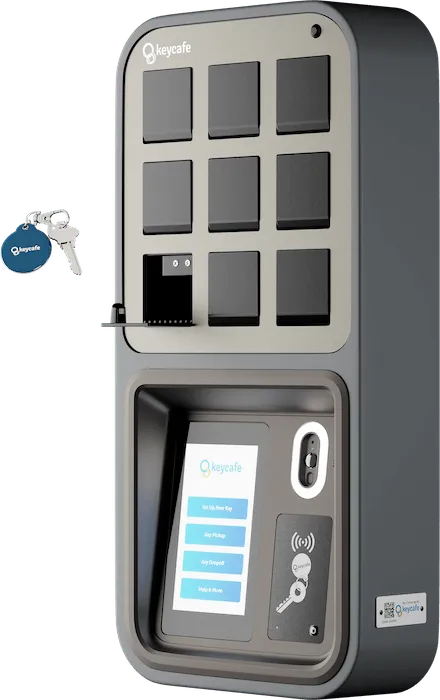0 minutes
Écrit par
Gideon Leung
Publié le
October 18, 2021
Publié le
October 18, 2021
Modifié le
November 28, 2025
Retour


Si votre entreprise utilise plusieurs jeux de clés et gère des employés avec différents niveaux d'accès, un système de gestion de clés est essentiel. Mais qu'est-ce qu'un système de gestion de clés ? Et en quoi est-ce utile ?
Aujourd'hui, nous allons explorer les subtilités des systèmes de gestion des clés d'entreprise et expliquer comment ils peuvent vous aider à simplifier l'accès, à améliorer la responsabilisation et à réduire les risques dans vos opérations quotidiennes.
La gestion des clés est essentielle dans toute organisation qui gère plusieurs clés ou ensembles de clés utilisés par plusieurs personnes.
Plus vous devez gérer de personnes et de clés, plus le processus devient complexe. Un système de gestion des clés garantit que seules les bonnes personnes ont accès au bon moment et vous permet de savoir qui a les clés en sa possession.
Les types d'entreprises qui utilisent ou nécessitent la gestion des clés comprennent les concessionnaires automobiles, les sociétés de gestion immobilière, les opérateurs de location à court terme (STR), les entreprises de construction, les prestataires logistiques, les gestionnaires d'installations, les hôtels, les agences de location de voitures, les flottes de véhicules gouvernementaux, les universités et des dizaines d'autres secteurs et cas d'utilisation.
Un système de gestion des clés facilite la prise en charge et la remise des clés à un endroit spécifique sans qu'il soit nécessaire de recourir à la supervision du personnel, tout en garantissant un haut niveau de responsabilisation.
Un système de gestion de clés conserve les clés dans un endroit central et accessible et vous permet d'attribuer des autorisations afin que seuls les utilisateurs autorisés puissent les récupérer. Une application logicielle basée sur le cloud contrôle l'accès, vous fournissant l'historique des accès pour chaque clé et chaque utilisateur en temps réel, simplifiant et automatisant la gestion des clés, même sur plusieurs sites et propriétés.
Les responsables peuvent définir des autorisations à distance en fonction de cartes d'accès, de codes PIN uniques, de délais et d'autres paramètres afin de garantir que seules certaines personnes peuvent accéder aux clés et que les clés des actifs critiques sont toujours disponibles en coordination avec les opérations de l'entreprise. Selon le niveau des besoins de votre organisation, les principaux systèmes de gestion peuvent être intégrés à l'infrastructure informatique et aux flux de travail de l'entreprise.
Un système de gestion de clés automatise et simplifie ce qui serait généralement un processus complexe, inefficace et chronophage dans l'entreprise. Voici quelques-uns de ses avantages.
Les principaux systèmes de gestion sont utilisés depuis des décennies sous une forme ou une autre. Voici les types les plus courants de systèmes de gestion de clés manuels et basés sur la technologie :
Le bon système de gestion de clés peut vous aider à réduire les coûts, à automatiser et à simplifier les processus, et à gagner en efficacité afin d'apporter une valeur ajoutée à l'utilisateur final et à vos résultats. Lorsque vous choisissez le système de gestion de clés qui vous convient, tenez compte de vos besoins et de vos priorités, des personnes qui utiliseront le système et de la facilité de gestion du flux de travail.
Voici quelques éléments à prendre en compte :
Nous espérons que vous avez pris connaissance des avantages des systèmes de gestion de clés pilotés par logiciel et de la manière dont ils peuvent aider votre entreprise.
Keycafe propose une gestion complète des clés à distance via une application mobile ou de bureau très conviviale. Keycafe propose une gamme complète de types d'autorisations, allant des simples codes de touche attribués à une clé aux codes utilisateur qui limitent l'accès en fonction de la durée ou du nombre de clés. Keycafe offre également la possibilité d'utiliser l'authentification à deux facteurs pour une plus grande tranquillité d'esprit. Le système de casier à clés Keycafe, appelé "SmartBox", garantit que chaque jeu de clés est caché et empêche tout accès non autorisé.
Une consultation avec un représentant de Keycafe vous permettra de savoir quel flux de travail convient le mieux à votre organisation afin que vous puissiez tirer le meilleur parti du système. Contactez-nous dès aujourd'hui, et entamons la conversation.
La mise en place d'un système de gestion de clés améliore la sécurité globale d'une organisation en l'intégrant à des mesures de sécurité plus larges, en garantissant uniquement les accès autorisés et en suivant l'utilisation des clés.
Les économies de coûts découlent de la réduction des pertes dues à l'égarement des clés et de l'amélioration de l'efficacité opérationnelle, bien que les spécificités varient en fonction de la taille de l'organisation et de la complexité du système.
À mesure que la technologie évolue, les systèmes de gestion de clés intègrent de plus en plus les clés numériques et l'accès mobile, proposant des solutions évolutives capables de s'adapter aux futures tendances en matière de sécurité et aux avancées technologiques.
